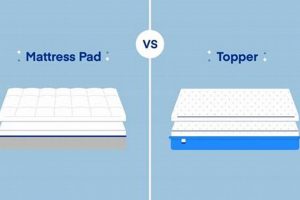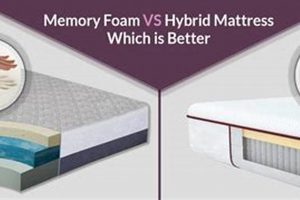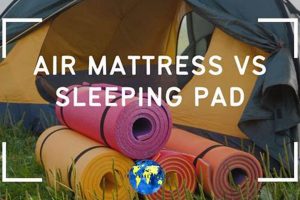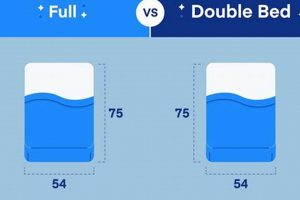The selection of a mattress often involves navigating a landscape of varied construction types, each offering a unique sleep experience. Common options include designs that combine multiple materials, those incorporating a gel-infused layer, and traditional spring-based models. Understanding the characteristics of each construction is crucial for informed decision-making.
The importance of this decision stems from the direct impact a mattress has on sleep quality, and subsequently, overall health and well-being. Historically, innerspring models dominated the market, but advancements in materials science have led to the development of newer technologies. The potential benefits of these alternatives include enhanced comfort, improved support, and temperature regulation.
This article will delve into the specific construction, advantages, and disadvantages associated with each mattress type, providing a detailed comparison to assist individuals in choosing the option best suited to their individual needs and preferences. This will involve an examination of the materials used, the level of support provided, and the likely longevity of each type.
Selecting the appropriate mattress type requires careful consideration of individual needs and preferences. Evaluating the characteristics of different constructions is essential for making an informed decision. The following points offer guidance in this process.
Tip 1: Understand Construction Differences: Recognize that hybrid models combine materials such as foam and coils, gel-infused designs focus on temperature regulation, and innerspring models prioritize traditional support. Each construction offers a unique feel and performance.
Tip 2: Evaluate Support Requirements: Assess individual support needs based on sleeping position and body weight. Innerspring mattresses may offer firmer support, while hybrid or gel-infused options can provide more conforming support.
Tip 3: Consider Temperature Sensitivity: Individuals prone to overheating during sleep should explore gel-infused or hybrid models designed for enhanced breathability and temperature regulation.
Tip 4: Assess Motion Isolation: If sharing a bed, consider the motion isolation properties of each mattress type. Hybrid and gel-infused designs often excel in minimizing motion transfer compared to traditional innerspring models.
Tip 5: Investigate Durability and Longevity: Research the typical lifespan of each mattress type and consider the quality of materials used. Higher quality materials generally contribute to increased durability.
Tip 6: Read Reviews and Seek Recommendations: Prioritize verified reviews from unbiased sources and seek recommendations from individuals with similar sleep preferences to gain valuable insights and real-world experiences.
Tip 7: Test Before Purchasing: Whenever possible, test mattresses in person to assess comfort and support levels. This hands-on approach is crucial for determining personal suitability.
By carefully considering these factors, individuals can make a more informed decision when selecting a mattress, prioritizing factors like support, temperature regulation, motion isolation, and long-term durability.
The following sections will provide a more in-depth analysis of each mattress type, further aiding in the selection process.
1. Construction Materials
The materials utilized in mattress construction directly influence performance characteristics such as support, comfort, temperature regulation, and durability. In hybrid models, a combination of materials, typically including innerspring coils and layers of foam (memory foam, latex, or polyurethane), aims to achieve a balanced sleep surface. The coil system provides structural support and promotes airflow, while the foam layers offer pressure relief and contouring. The specific type and density of foam used significantly impact the overall feel and responsiveness of the mattress. For example, a hybrid mattress incorporating high-density memory foam will likely exhibit greater body-conforming properties compared to one using a less dense polyurethane foam.
Gel-infused mattresses primarily utilize foam infused with gel particles. These particles are intended to absorb and dissipate heat, promoting a cooler sleep environment. The efficacy of gel infusion varies depending on the concentration of gel and the type of foam used. Lower quality gel-infused foams may exhibit diminished cooling properties over time, whereas higher quality options can maintain a more consistent temperature. The support core of a gel-infused mattress can range from a traditional foam base to a system of pocketed coils, thereby influencing its overall firmness and responsiveness. The quality and density of the core materials determine the longevity and resistance to sagging.
Traditional innerspring mattresses consist primarily of a coil system covered by layers of padding. The type of coil system (e.g., Bonnell, continuous, or pocketed) dictates the level of support and motion isolation. Bonnell coils, being interconnected, tend to transfer motion more readily than individually pocketed coils. The comfort layers atop the coils, typically composed of materials like fiberfill, cotton, or thin layers of foam, contribute to the initial feel of the mattress but may compress over time, reducing their effectiveness. The gauge (thickness) of the coils and the quality of the padding materials are key determinants of the mattress’s durability and resistance to deformation. In summary, material selection is a critical factor dictating performance and lifespan across different mattress types. Understanding these material properties empowers consumers to make informed decisions that align with their specific needs and preferences.
2. Support Structure
The support structure within a mattress is a critical determinant of spinal alignment, pressure distribution, and overall sleep comfort. The design and materials used in this component dictate the mattress’s ability to maintain proper posture and minimize discomfort, particularly for individuals with specific orthopedic considerations. Understanding the variations in support structure across different mattress types is essential for making an informed purchasing decision.
- Coil Systems in Innerspring and Hybrid Mattresses
In innerspring mattresses, the coil system provides the primary source of support. The type of coil (e.g., Bonnell, offset, continuous, or pocketed) affects the mattress’s firmness, responsiveness, and ability to isolate motion. Hybrid mattresses also incorporate coil systems, often utilizing pocketed coils to minimize motion transfer. The gauge (thickness) and arrangement of the coils determine the level of support provided. For instance, a mattress with thicker gauge coils will generally offer firmer support than one with thinner gauge coils. The design and configuration of the coil system directly impact the mattress’s ability to conform to the sleeper’s body and maintain spinal alignment.
- Foam Core in Gel-Infused Mattresses
Gel-infused mattresses commonly utilize a foam core as their primary support structure. The density and type of foam (e.g., high-density polyurethane, memory foam) influence the mattress’s firmness, responsiveness, and ability to distribute weight evenly. Higher density foams typically provide greater support and durability. The inclusion of gel-infused layers within the foam core aims to enhance temperature regulation. However, the effectiveness of gel infusion depends on the concentration of gel particles and the quality of the foam. The overall support provided by the foam core directly impacts the sleeper’s comfort and spinal alignment.
- Zoning and Targeted Support
Many modern mattresses, including hybrid and some gel-infused models, incorporate zoning to provide targeted support to different areas of the body. Zoning involves varying the firmness or coil density in specific regions of the mattress, such as the lumbar region or the shoulders. This targeted support aims to promote spinal alignment and reduce pressure points. For example, a mattress with enhanced lumbar support may help prevent lower back pain. The effectiveness of zoning depends on its design and how well it aligns with the individual’s body shape and sleeping position. In contrast, traditional innerspring mattresses often lack targeted zoning, potentially leading to uneven support and discomfort.
- Edge Support Considerations
Edge support refers to the structural reinforcement along the perimeter of the mattress. Strong edge support prevents the edges from collapsing or sagging, providing a stable sleeping surface and facilitating getting in and out of bed. Innerspring and hybrid mattresses often incorporate reinforced edges using thicker coils or foam encasements. Gel-infused mattresses with foam cores may utilize high-density foam along the edges to enhance support. Adequate edge support is particularly important for individuals who sleep near the edge of the bed or require assistance getting in and out of bed.
In conclusion, the support structure is a fundamental aspect of mattress design that significantly impacts sleep quality and spinal health. The choice between coil systems, foam cores, zoning, and edge support should be carefully considered based on individual needs and preferences. A thorough understanding of these structural elements allows consumers to make informed decisions that promote optimal sleep comfort and long-term well-being when choosing between an innerspring, hybrid, or gel-infused mattress.
3. Temperature Regulation
Temperature regulation is a critical factor influencing sleep quality. Mattress construction significantly impacts heat retention and dissipation, influencing the sleeper’s thermal comfort throughout the night. Different mattress typeshybrid, gel-infused, and innerspringexhibit varying capabilities in managing temperature.
- Airflow and Breathability
Airflow within a mattress promotes heat dissipation and reduces humidity. Innerspring mattresses, with their open coil structure, generally offer superior airflow compared to denser foam-based designs. Hybrid mattresses, which combine coils with foam layers, may offer a compromise between support and breathability depending on the specific foam types used. Gel-infused mattresses, while incorporating cooling gels, can sometimes restrict airflow due to the density of the foam, potentially leading to heat buildup if not properly engineered.
- Material Properties and Heat Absorption
Different materials exhibit varying levels of heat absorption and retention. Memory foam, known for its conforming properties, also tends to retain heat, potentially causing discomfort for individuals prone to overheating. Latex foam, on the other hand, offers better breathability and less heat retention. Gel-infused foams aim to mitigate the heat-retaining properties of conventional foam by incorporating gel particles that absorb and dissipate heat. The effectiveness of gel infusion depends on the quality and concentration of the gel.
- Surface Treatments and Cooling Technologies
Mattress manufacturers often employ surface treatments and specialized technologies to enhance temperature regulation. These may include breathable fabrics, moisture-wicking materials, or phase-change materials that absorb and release heat to maintain a consistent temperature. Hybrid and gel-infused mattresses often incorporate these technologies to counteract the heat-retaining properties of foam. Innerspring mattresses may utilize breathable ticking or quilted covers to further enhance airflow.
- Impact of Sleeping Position and Environmental Factors
Sleeping position and environmental factors, such as room temperature and bedding materials, can also influence temperature regulation. Individuals who sleep on their stomach may experience greater heat retention due to increased contact with the mattress surface. Similarly, using heavy blankets or sleeping in a poorly ventilated room can exacerbate heat buildup. The effectiveness of a mattress’s temperature regulation capabilities can be significantly influenced by these external factors, necessitating a holistic approach to thermal comfort management.
In conclusion, the ability of a mattress to regulate temperature is a crucial aspect of sleep comfort. Innerspring mattresses generally offer better airflow due to their coil construction, while hybrid and gel-infused mattresses rely on material properties, surface treatments, and cooling technologies to manage heat retention. Understanding these factors allows consumers to make informed decisions about the most suitable mattress type for their individual needs and preferences, considering both the mattress’s inherent properties and external influences on thermal comfort.
4. Motion Isolation
Motion isolation, the ability of a mattress to minimize the transfer of movement across its surface, constitutes a significant factor in sleep quality, especially for co-sleepers. The construction of a mattress fundamentally dictates its motion isolation capabilities. Innerspring mattresses, characterized by interconnected coils, tend to exhibit the least effective motion isolation. Movement on one side of the mattress readily transmits to the other, potentially disturbing a sleeping partner. This is due to the coil system acting as a single unit, where pressure applied to one area affects the surrounding coils.
Hybrid mattresses, incorporating pocketed coils and foam layers, typically offer improved motion isolation compared to traditional innerspring models. Pocketed coils, individually wrapped in fabric, respond independently to pressure, reducing the ripple effect of movement. The foam layers further dampen motion transfer, with memory foam proving particularly effective due to its high density and ability to absorb energy. For instance, if one partner shifts positions or gets out of bed, the other partner experiences minimal disturbance. Gel mattresses, primarily composed of foam, often provide the best motion isolation due to foam’s inherent ability to absorb and dissipate movement. High-density gel-infused memory foam excels in preventing motion transfer, making it a favorable choice for couples with disparate sleep schedules or restless sleeping habits. The practical implication of understanding these differences lies in selecting a mattress that minimizes sleep disruptions caused by a partner’s movements.
In summary, motion isolation is an important consideration when evaluating different mattress types. The interconnected coil design of innerspring mattresses tends to transmit motion, while hybrid and gel models, particularly those with pocketed coils or dense foam layers, significantly reduce motion transfer. The optimal choice depends on individual needs and preferences, especially for those sharing a bed. Addressing the challenge of sleep disturbance caused by motion requires a careful assessment of mattress construction and its impact on motion isolation.
5. Durability Expectations
The longevity of a mattress is a primary concern for consumers, directly impacting the overall value proposition. Variations in construction and materials across hybrid, gel, and innerspring mattress types influence their respective lifespans. Understanding these differences is critical for making an informed purchasing decision that aligns with long-term expectations.
- Coil System Fatigue and Degradation
The coil system in innerspring and hybrid mattresses is a key determinant of durability. Over time, coils can lose their resilience due to repeated compression and stress, leading to sagging and reduced support. The gauge (thickness) of the coils and the quality of the steel used affect their resistance to fatigue. In hybrid models, the interaction between the coils and the foam layers can also influence durability, as the foam may degrade before the coils. Regular rotation of the mattress can help distribute wear and extend its lifespan, while coil fatigue is typically observed in older mattresses exhibiting noticeable impressions or lack of support.
- Foam Density and Compression Set
Foam-based mattresses, including gel-infused and hybrid models, are susceptible to compression set, a phenomenon where the foam permanently deforms under pressure. The density of the foam is a critical factor, with higher density foams generally exhibiting greater resistance to compression set. Over time, the foam may lose its original loft and firmness, leading to reduced comfort and support. Gel-infused foams, while offering cooling properties, are still subject to the same degradation processes as conventional foams. High-quality foams, particularly those used in the comfort layers of hybrid mattresses, are often treated to resist compression and maintain their shape for a longer period.
- Material Quality and Construction Integrity
The overall quality of the materials used in mattress construction significantly impacts its durability. Higher quality materials, such as durable fabrics, high-density foams, and tempered steel coils, contribute to a longer lifespan. The construction integrity, including the stitching, quilting, and edge support, also plays a crucial role. Weak seams or poorly constructed edges can lead to premature wear and tear. Regular inspection and proper maintenance can help identify and address potential issues before they escalate.
- Warranty Coverage and Customer Reviews
Warranty coverage provided by the manufacturer can offer insights into their confidence in the product’s durability. Longer warranty periods typically indicate a higher level of quality and reliability. Customer reviews can also provide valuable feedback on the real-world durability of different mattress types. Paying attention to both warranty terms and customer experiences can help manage expectations and make a more informed decision. However, it is important to note that warranty coverage usually only covers manufacturer defects and not normal wear and tear.
In conclusion, durability expectations are contingent upon the materials and construction methods employed in hybrid, gel, and innerspring mattresses. Coil fatigue, foam compression, material quality, and construction integrity all contribute to the overall lifespan of the mattress. Considering these factors, alongside warranty coverage and customer reviews, enables consumers to select a mattress that aligns with their desired longevity and long-term comfort needs.
Frequently Asked Questions
The following questions address common inquiries and misconceptions regarding different mattress constructions.
Question 1: Which mattress type generally offers the best support for individuals with back pain?
The ideal support structure depends on individual needs. Hybrid mattresses, combining pocketed coils and foam layers, often provide a balanced combination of support and pressure relief. However, a firm innerspring mattress can also offer adequate support for some individuals with back pain. Consulting with a healthcare professional is advisable for personalized recommendations.
Question 2: How do gel-infused mattresses regulate temperature compared to traditional innerspring models?
Gel-infused mattresses utilize gel particles within the foam to absorb and dissipate heat, aiming to maintain a cooler sleep surface. Innerspring mattresses, with their open coil construction, promote airflow, naturally reducing heat retention. The effectiveness of gel infusion varies depending on the quality and concentration of the gel particles.
Question 3: What are the primary factors influencing the durability of a hybrid mattress?
The durability of a hybrid mattress is contingent upon the quality of both the coil system and the foam layers. High-density foams and tempered steel coils contribute to a longer lifespan. Regular rotation of the mattress can also help distribute wear and extend its useful life.
Question 4: Are innerspring mattresses suitable for individuals sharing a bed with a restless sleeper?
Innerspring mattresses, due to their interconnected coil design, tend to transmit motion more readily than other mattress types. This can lead to sleep disturbances for co-sleepers. Hybrid or gel-infused mattresses, with pocketed coils or dense foam layers, offer better motion isolation.
Question 5: How often should mattresses be replaced to ensure optimal support and hygiene?
The recommended replacement frequency for mattresses typically ranges from seven to ten years. However, factors such as mattress quality, usage, and individual health needs can influence this timeline. Signs of wear, sagging, or diminished support warrant consideration for replacement.
Question 6: What are the key considerations when selecting a mattress for a guest room?
For guest rooms, a versatile mattress that accommodates a range of sleep preferences is ideal. A mid-firmness hybrid mattress often provides a balance of support and comfort. Prioritizing durability and ease of maintenance is also advisable, given infrequent use.
Understanding these common concerns is a vital step to achieving a restful sleep experience.
The subsequent discussion transitions into practical recommendations for mattress care and maintenance, further enhancing the longevity and performance of the chosen sleep surface.
Concluding Insights
The preceding examination of “hybrid vs gel vs innerspring mattress” construction underscores the nuanced differences in support, temperature regulation, motion isolation, and durability. Informed selection necessitates a careful evaluation of individual needs and preferences, considering factors such as sleeping position, body weight, and sensitivity to motion or temperature. The characteristics of each construction typecoil systems, foam density, material qualitydirectly impact the long-term performance and comfort of the sleep surface.
The decision to prioritize one mattress type over another constitutes a significant investment in long-term well-being. The optimal selection requires a thorough assessment of personal requirements and a realistic understanding of the inherent strengths and limitations associated with each design. Continuing advancements in materials science and sleep technology suggest a future landscape of increasingly sophisticated and customizable sleep solutions, further underscoring the importance of informed consumer choices. Prioritizing research and consulting with sleep professionals may enhance the selection process.




![Bear vs Saatva Mattress: Which Bed is Best [Review]? Organic & Natural Mattress Buyer’s Guide: Non-Toxic Sleep Solutions Bear vs Saatva Mattress: Which Bed is Best [Review]? | Organic & Natural Mattress Buyer’s Guide: Non-Toxic Sleep Solutions](https://mattressworldpa.com/wp-content/uploads/2025/07/th-1052-300x200.jpg)


